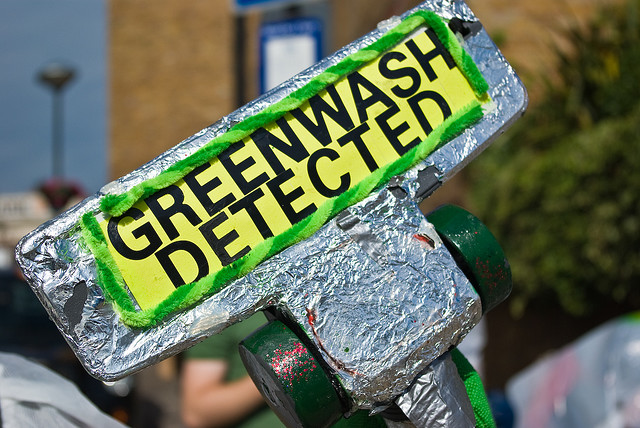
Dudley Gann Explains: What Is Greenwashing and How to Avoid It

Is it truly ecological or a matter of greenwashing? Know the difference.
Modern consumers are increasingly conscious of the social and environmental impacts of the products and services they purchase, preferring to do business with companies that show ethical practices, and that they are committed to positive social and environmental impacts. In a 2020 survey of consumer sentiment in the United States, over 60 percent of respondents said that they would be willing to pay more for a product with sustainable packaging. Another recent study conducted by NielsenIQ found that 78 percent of U.S. consumers say that a sustainable lifestyle is important to them.
Industrialism has led to incredible advancements that make modern life what it is today. However, it’s becoming evident that our business practices have impacts beyond just profits, affecting our planet and society. This realization means it’s crucial for both big and small companies to reassess their operations with sustainability in mind. Despite this, the growing demand for sustainable businesses has led some companies to engage in “greenwashing,” an unethical practice that involves making false or baseless claims about being environmentally friendly, exploiting the benefits of a green image without genuine action.
According to Dudley Gann, founder of the green consulting firm EcoVision Solutions, he often encounters clients who have a desire to incorporate more sustainable practices into their business, but fear that if they do not tackle every single minute aspect of eco-friendly practices they will be accused of greenwashing.
“Many of my clients share a common fear—they worry that any effort towards sustainability that isn’t perfect will be seen as greenwashing,” said Gann. “But the journey to becoming more sustainable doesn’t require immediate perfection. Needing time to adjust resources and introduce new practices isn’t dishonest—it’s a part of the process. The key to genuinely integrating sustainable solutions into a business is to enhance transparency. Being open about where you are in your sustainability journey helps build trust and shows a commitment to real change.”
Before founding his consulting firm, Gann spent over two decades working in green technology. His business EcoVision Solutions offers guidance to businesses seeking to adopt more environmentally friendly practices, providing customized solutions that align with their specific environmental goals. He regularly contributes to various blogs and publications, focusing on sustainable business practices, and has additionally spoken at several conferences on the subject.
The concept of greenwashing
It’s crucial to define what greenwashing is and what it isn’t. Greenwashing occurs when companies falsely claim to be environmentally friendly or socially responsible without evidence to support these claims.
Unfortunately, the growing popularity of sustainability and green initiatives among stakeholders is fueling greenwashing. As consumers and investors increasingly prefer companies committed to responsible and sustainable practices, some businesses may resort to greenwashing as a shortcut to attract this eco-conscious market, despite lacking genuine sustainable actions.
“Greenwashing will usually involve focusing on short-term, convenient, superficial issues rather than addressing long-term challenges that would truly benefit society and the environment,” said Dudley Gann. “Leaders who go down this path might not see the double whammy they’re setting up for their company. Not only are they missing the mark on addressing real issues, but they’re also flirting with a major reputational hit and a trust meltdown if their dishonesty comes to light.”
Greenwashing often shows up as a lack of evidence or third-party validation for eco-friendly claims. It might involve using broad terms like ‘environmentally friendly’ without offering specifics, ignoring the company’s less sustainable practices, making green claims irrelevant to the product or company, or simply stating claims that are outright false. In 2021, the European Commission and National Consumer Authorities conducted an investigation of online marketplaces for signs of greenwashing. They found that 42 percent of the environmental claims they reviewed were exaggerated, false, or misleading.
Some companies engaged in greenwashing focus their marketing efforts on promoting the eco-friendly aspects of their business, ignoring the parts that are not environmentally friendly. Meanwhile, other companies resort to outright lies, intentionally deceiving customers and regulators with false information. However, being accused of greenwashing doesn’t always imply bad intentions. Sometimes, it may simply be due to poor communication. Vague environmental claims that lack clear, verified data can seem dishonest, even if there is some truth to them. In other cases, companies might set overly ambitious sustainability goals that they ultimately fail to achieve, not because they didn’t want to, but because the goals were too challenging to meet.
“Greenwashing does not apply to companies that are genuinely working towards sustainability, even if they are just beginning to put these practices into place,” Gann said.
The far-reaching impact of greenwashing
As previously discussed, greenwashing can significantly undermine consumer trust and loyalty. This breach not only damages the brand-consumer relationship, but also reduces customer loyalty. Additionally, a pervasive culture of greenwashing breeds skepticism among consumers towards all environmental claims, making it difficult for companies genuinely committed to sustainability to gain recognition and trust.
The environmental and social consequences of greenwashing are equally concerning. It misleads the public about what environmental issues should be prioritized, diverting attention from urgent problems that require immediate action. This shift can stifle true innovation in sustainable technologies and practices because companies may opt to spend more on marketing their products as “green” rather than investing in genuine environmental improvements. Furthermore, greenwashing could unintentionally result in weaker environmental rules and policies. When it’s hard to tell apart real sustainability actions from greenwashing, policymakers might end up setting less strict rules, not fully tackling the biggest environmental issues.
“The impact of greenwashing extends way beyond the immediate effects on consumer behavior. It creates serious difficulties for environmental sustainability and social equity. Addressing greenwashing is essential for fostering a more honest, more responsible, genuinely sustainable future,” Gann said.
How to avoid greenwashing

Estee Lauder in Canada sets up solar power on the roof of the manufacturing facility. Businesses can do this as well as individuals.
According to Dudley Gann, in order to avoid greenwashing companies need to deeply integrate sustainability into their core mission and values. This involves making environmental responsibility a fundamental aspect of the business model itself, rather than an afterthought or a marketing strategy. Here’s how to do it:
Embed sustainability in the mission: Make sustainability a central component of the company’s mission statement. This ensures that all stakeholders, from employees to investors, understand that environmental responsibility is a key priority.
Incorporate it into the business model: Design the company’s operations, products, and services around sustainable practices. This could mean opting for eco-friendly materials, investing in renewable energy, or developing products that have a smaller environmental footprint.
Set clear sustainability metrics: Establish specific, measurable goals for sustainability efforts, such as reducing carbon emissions, minimizing waste, or increasing the use of renewable resources. Use these metrics to track progress and make adjustments as needed.
Hold everyone accountable: Implement standards for sustainability that apply to everyone in the company, from the CEO to entry-level employees. Encourage a culture where sustainability is everyone’s responsibility, and where individuals and teams are held accountable for meeting environmental goals.
Continuous education and training: Educate employees about the importance of sustainability and train them in specific practices that can help achieve the company’s environmental goals. This can help ensure that everyone is equipped to contribute to the sustainability mission.
Transparent reporting: Regularly report on the company’s sustainability efforts and progress towards its goals. Being open about both successes and areas for improvement can help build trust with consumers, investors, and other stakeholders.
Engage with stakeholders: Listen to customers, employees, and partners about their views on sustainability and how the company can improve its practices. Engaging with stakeholders can provide valuable insights and demonstrate a genuine commitment to environmental responsibility.
“Getting to sustainability isn’t about nailing it perfectly right out of the gate. It’s more about being open and honest, taking small steps to get better over time. When a company really makes sustainability part of its DNA—like, it’s in everything they do, from their big mission down to the nitty-gritty daily stuff—that’s when they start to make a real splash,” Gann said.
Comments
creditSource link




